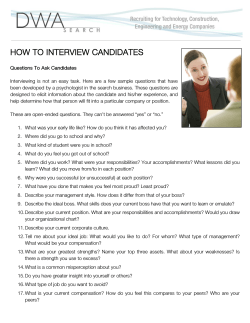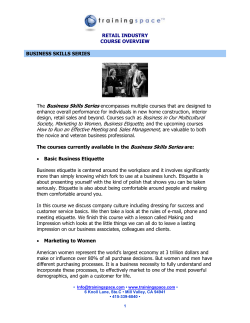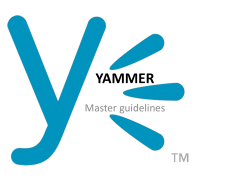
College and University Guidance Manual
p1 Institute of Image Training and Testing International (IITTI)
TM
College and
University
Guidance Manual
June 30, 2014
November 15, 2012
Revision 1 Dec12,2012
(Editors please see working .doc copy for changes highlighted in red.)
2011-2014 Institute of Image Training and Testing International (IITTI).
You can freely distribute this document.
www.IITTI.org
College and University Guidance Manual
Table of Contents
Chapter 1 The Business Case............................................................3
The interview disaster: a real-life story............................................................................................3
Challenges facing college graduates.................................................................................................3
Challenges facing corporate HR.......................................................................................................3
A lose-lose-lose situation..................................................................................................................4
The solution......................................................................................................................................4
Chapter 2 The IITTI Exam...................................................................5
What is the Exam like?.....................................................................................................................5
Anything fun?...................................................................................................................................6
What does the Exam actually look like?...........................................................................................7
Chapter 3 How can we work with IITTI?..............................................8
What is the first step?.......................................................................................................................8
How can we take advantage of the IITTI certification system?.......................................................8
www.IITTI.org
p2
p3 Institute of Image Training and Testing International (IITTI)
Chapter 1 The Business Case
The interview disaster: a real-life story
A recent college graduate walked into the room for an interview with a major international
financial institute. This candidate had excellent academic record. He spoke well and was
well-informed of the current business news within the industry. Everything was going well for
him... until... he took out his cell phone to check his messages in the middle of the interview,
while his potential employer was waiting for him.
Needless to say, he didn't get the job. Worst, he never found out the reason why.
Challenges facing college graduates
Most college graduates come out into the working world armed with a wealth of knowledge in
their field of study. But many lack the kind of training and awareness about people skills that
would get them hired, and, perhaps more importantly, help them keep their jobs and get
promotions.
Many schools offer interview training. Some progressive institutes are even beginning to offer
business etiquette training for graduating students. This is a very good trend. But this is just
half of the story. The other half lies with the employers.
Challenges facing corporate HR
1. No standardization in image curricula.
Currently, a corporate human resource (HR) professional can't easily judge image and
etiquette training because different training from different institutes may mean different
outcomes. It would be like asking HR's to compare somebody with a kindergarten education
vs. another person with a high school education.
2. A lack of a standardized measurement system for soft skills.
In-depth discussions with HR professionals would reveal that it is not that they don't demand
appropriate appearance, behavior, or communication during the hiring process, but the lack of
a standardized measurement which causes confusion, leaving HR's unsure about what they
should expect of their employees. A standardized certification system would eliminate this
issue of comparing apples and oranges.
www.IITTI.org
College and University Guidance Manual
p4
A lose-lose-lose situation
A. The Employee – The job candidate does not receive the credit he/she deserves for his/her
business etiquette training. If the employer is unfamiliar with a particular training program,
he/she might not get the job or the promotion.
B. The Employer – The employer loses because they don't have a standardized way to
measure soft-skills, and may suffer from employees having inappropriate professional
behaviour, communication skills and appearance.
C. Your Institute – If your training program does not receive the recognition it deserves for its
quality training in the market place, your institute may receive lower enrollment.
The solution
An independent, international business image and etiquette testing system would solve this
issue. And that is what the non-profit group called IITTI ("ET") is setting out to do.
IITTI is industry-driven, and was founded by an international group of veteran image and
etiquette consultants. One can think of IITTI as the ISO or TOEFL standard for interpersonal
skills.
It ensures the market all "speaks the same language". When all parties are "on the same
page", it streamlines the inefficiencies. Your students would know exactly what they receive at
the end of the training (and tell prospective employers). With clear standards and
measurements, HR's would be more likely to see the benefits of your training.
In short, when your students succeed in business, your school benefits.
www.IITTI.org
p5 Institute of Image Training and Testing International (IITTI)
Chapter 2 The IITTI Exam
What is the Exam like?
There are three (3) levels of certification:
(1) Level 1, Basic
(2) Level 2, Standard
(3) Level 3, Advanced
We find it useful to describe each level with a single word or phrase; this allows everybody to
describe very concisely what each level is about:
(1) Level 1, Basic
- "keeping up"
(2) Level 2, Standard - "fluency"
(3) Level 3, Advanced – "refined"
Why three levels? There is a market reason for these categories. Think of Level 1 as the
"survival", or "keeping up" level. It is designed to evaluate your graduating students'
interpersonal skills in the three areas of business etiquette: business dress, business
behaviour, and dining etiquette for business interaction. Passing this exam ensures that the
student can identify appropriate and inappropriate behaviour - and have the necessary
knowledge to not embarrass themselves (and your school!) at a job interview. It is a vehicle
that allows you to raise the general awareness of the importance of appropriate appearance,
behaviour and business communication at your institute. It is about improving the school
culture, and thus your brand.
With this in mind, the IITTI Level 1 is designed to be a compact unit. It is not a full-fledged
business etiquette exam. It tests the knowledge that is minimally acceptable for the
uninitiated. Any student who aspires to work with people in the international market would be
a good candidate. It is a "catch all".
Level 1 exam is designed to verify the foundational skills. These skills may be further
enhanced through any future company-specific training, or through enhanced training criteria
at your institute in preparation for the IITTI Level 2 exam.
Level 2 is designed for a more particular group of audience. It is meant to be a full-fledged,
wide-spectrum delivery for people who really want to have an advantage in their own
branding. While Level 1 is there to help prevent people from making big mistakes that would
embarrass themselves and the school that they came from, Level 2 is there to help people
stand out in the crowd.
We ask Level 1 candidates to demonstrate knowledge, with only a written test. But Level 2 is
where the "rubber meets the road"; not only would candidates need to sit for a written exam,
www.IITTI.org
College and University Guidance Manual
p6
but it is also where they would need to physically demonstrate their skills in front of an
examiner. There is no faking it!
At a Level 2 practicum exam, candidates would need to demonstrate fluency in the execution
of their skills. For example, if the examiner asks a candidate to demonstrate the American
style of dining, we would expect the candidate not to hesitate in transferring the fork from the
left hand to the right for eating.
At Level 2, expected skills should be second-nature. Successful candidates are those who
have formed good habits by putting into practice the learned skills. You may call it a form of
"muscle memory", just like top athletes can perform their skills "in their sleeps"!
Level 3 is a high-level critique for managers of multinationals and other professionals, and is
beyond the scope of this document.
Anything fun?
We ask Level 2 candidates to produce their own home-made video about business image
and etiquette skills they have learned! And IITTI will rate them.
The videos can be something minor, like holding open a door for people behind them at a
shopping mall, or giving up their seats on a bus for the elderly. It is not meant for students to
need to spend a lot of money in doing; even a cellphone video could suffice, but the content
message has to be sound.
Why are we asking this? It is a way to get students to be thinking about what they would
consider important. By going through the process of taking the video, they each would need
to plan, design, and act; something that they will remember for a long time.
www.IITTI.org
p7 Institute of Image Training and Testing International (IITTI)
What does the Exam actually look like?
The computerized, written part of the Exam is web-based.
For example, Level 1 certification requires only a computerized exam, and consists of four (4)
separate sections in total of fill-in-the-blank and multiple-choice questions with their
respective weights of:
1. General
0%
2. Professional Appearance 30%
3. Business Etiquette
34%
4. Dining Etiquette
36%
The "General" section is in a fill-in-the-blank format. It asks survey questions about whether
the exam candidate had prior training, etc. Although the General section carries zero weight,
it is a compulsory section. The other three sections are in a multiple-choice format, asking
technical questions in their respective subject matters.
Here is what the actual screen looks like:
www.IITTI.org
College and University Guidance Manual
p8
Chapter 3 How can we work with IITTI?
What is the first step?
The first thing to do is to contact us or a corporate image / etiquette trainer in your area to get
the latest copy of the IITTI Standards and Guidelines (S&Gs) document. This document
specifies all the standardized international corporate etiquette and image procedures, and will
give you a general idea of what is covered in each exam level.
The best way to contact us is to send us an email.
How can we take advantage of the IITTI certification system?
(1) You can suggest to your graduating students to take the IITTI test. (2) You can also offer
courses for students to be trained in image and etiquette awareness.
For the specifics of ways to work with IITTI, please don't hesitate to give us a call or email us.
Contact IITTI at:
Institute of Image Training and Testing International
Vancouver, Canada
Tel: (604) 231-8197
web: www.IITTI.org
email: info@IITTI.org
2011-2014 Institute of Image Training and Testing International (IITTI).
You can freely distribute this document.
www.IITTI.org
© Copyright 2025















